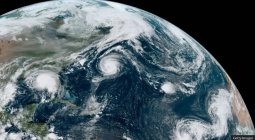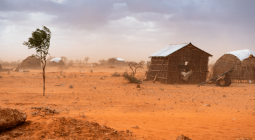From cyclone to drought, Zimbabwe’s climate victims struggle to adapt
Five years after Cyclone Idai devastated eastern Zimbabwe, relocated communities face a new threat – water shortages – with authorities saying they lack money to build a dam
It was water that stripped nearly everything from Tambudzai Chikweya’s life on the night of March 15, 2019.
As Cyclone Idai tore through Chimanimani, her hometown in Zimbabwe’s eastern highlands, it unleashed floods that swept away her house and claimed the life of her eldest daughter. Chikweya was rescued only after spending the night pinned between a wardrobe and a bed, unable to free herself from the mud.
More than five years later, water again stands in the way of Chikweya’s attempts to build a new life for herself and her family. But this time, the problem is that there isn’t enough of it.
The mother-of-three has been resettled in Runyararo, a vast expanse of sun-baked semi-arid land where the Zimbabwe government has been building brick homes for hundreds of people displaced by the cyclone, on the site of a former colonial farm more than 60 kilometres away from Chimanimani.
High temperatures of up to 34 degrees Celsius and erratic rainfall make access to water in Runyararo “inadequate”, according to government documents. The situation has been made worse this year by a severe drought – dubbed “historic” by the UN – which has affected much of Southern Africa and was sparked by the El Niño weather pattern.
“Not having enough water and drought-induced hunger are challenges here,” Chikweya said, speaking through a translator when Climate Home visited her home in Runyararo last September on a trip organised by Danish humanitarian NGO DanChurchAid.
“It was a very difficult decision for us [to move here],” she added, “It weighed on us for a long time.”
The reality has also proved tough. Standing in front of a small vegetable patch where she grows tomatoes and kale, Chikweya described the struggle she faces in getting enough food to feed herself and her children at least once a day.
She tried to grow potatoes on a large plot of land donated by the government – but the crops failed in the bone-dry soil as a result of the stifling heat and a shortage of water.
Climate Home asked Zimbabwe’s government why storm-hit communities were resettled in a known drought-prone area, but had not received a response by the time of the publication.
Multiple climate threats
Chikweya’s situation underscores the wide range of climate-related threats affecting vulnerable communities in a country like Zimbabwe where the frequency and intensity of both storms and droughts are projected to increase as the planet heats up.
The situation in Runyararo also highlights the complexities of the critical decisions facing cash-strapped governments that need to ensure their efforts to help people recover from one disaster also make them better able to withstand future hazards.
Mattias Söderberg, global climate lead at DanChurchAid, said adapting to multiple climate stresses “is not just a tick-box exercise”, but must be grounded in a “thorough assessment of the expected climate effects”.
Development organisations and government authorities leading adaptation projects need enough expertise to take into account expected climate impacts in the future as well as what is happening now. “Otherwise adaptation investment may be lost, and people will live in a false sense of safety,” Söderberg said.
Doing that in practice, however, can add to the upfront costs of adaptation measures. To tackle the lack of water in Runyararo, for example, the national government has sketched out plans to build a dam on a nearby river and bring a stable water supply into the area. But a lack of funding has put the dam project beyond reach for now.
It is a familiar dilemma for developing nations struggling to bridge the widening gulf between the impacts of climate change and the shortfall of money available to address them.
International public funding to protect communities in poorer, vulnerable countries from worsening extreme weather and rising seas is only a fraction – between 7% and 13% – of what is needed, according to the latest Adaptation Gap Report published on Thursday by the UN Environment Programme (UNEP).
UNEP said governments have an important opportunity to “alter this trajectory” at the upcoming COP29 summit, starting next week in Baku, Azerbaijan. The talks are expected to agree on a new post-2025 global climate finance goal to help developing countries tackle climate change – but deep divisions remain on what it should consist of, how large it should be, and who should contribute to it.
For Zimbabwe, the money could make all the difference when dealing with another climate disaster.
‘Surrounded by floodwater’
Back in 2019, Joseph Maphosa was fast asleep when the water brought by Cyclone Idai burst through the front door of his home late at night with such force that it lifted up his bed.
Idai was then passing through Kopa, a settlement lying on a plain at the confluence of three rivers. Conditions making it particularly prone to flooding and landslides would turn Kopa into the epicentre of the disaster.
After fleeing his house by hanging onto the roof trusses, Maphosa eventually climbed up into a tree with three of his neighbours. They spent the next 48 hours there alone.
“The rain was coming down all around us, there was nothing we could do,” he recounted more than five years later. “No one could help us because we were just surrounded by floodwater.”
By the time rescuers arrived and took the four people to safety, the water had started receding and the devastation caused by the cyclone was laid bare.
It was Zimbabwe’s most devastating natural disaster on record.
More than 70 households were swept away in Kopa alone. Across the country, 344 people died, with over 250 reported missing and 60,000 displaced by the disaster. The cost of damage to property and infrastructure ranged between $542 million and $616 million according to a rapid impact assessment by the World Bank which funded a wide-ranging recovery programme.
As the government and development agencies set about rebuilding homes, roads and bridges and restoring local people’s livelihoods, they promised that similar cyclones would never have the same calamitous consequences.
‘Building back better’
“We said, ‘we don’t need to build back better anymore – we want to build back better first time’,” John Misi, acting director for local government services in Manicaland Province, told reporters visiting the area in September.
“We challenged our local authorities that no one was going to build a structure, a home, a shelter, without getting technical support from the council so that we build more resilient infrastructure,” he added.
On a three-day trip across the province, Climate Home saw a mixed picture of how the recovery efforts have unfolded five years on from the dramatic events caused by Idai.
Key infrastructure – including many roads and bridges – was repaired, restoring access to remote communities.
Still, a large swathe of the floodplain in Kopa remains littered with giant boulders that came rolling down from the mountains as a result of the cyclone, destroying everything in their way.
Even so, a dozen metres away, the local business centre is a hive of activity. New buildings are being erected, helping locals to earn a living but also fuelling concerns over what would happen if a fresh climate disaster struck.
“There is no order – these businesses are just coming up,” said Maphosa, who now works in Chimanimani’s civil registry office. “It is a great risk to build there. [With Cyclone Idai] water got into the shops there but people are still building them there anyways.”
While commercial buildings are being constructed in Kopa, an official told Climate Home that the local council denied permission to rebuild residential houses there.
Most people made homeless by the disaster found shelter with families or host communities, but hundreds of households ended up in temporary camps waiting to be given a new permanent home elsewhere.
Settling in the ‘land of peace’
The centrepiece of the Zimbabwe government’s resettlement plans lies in Runyararo, which means “land of peace” in the local Shona language. The settlement lies at the end of a long dirt road nearly two-hours’ drive away from Chimanimani.
Here, on a largely empty piece of barren land traditionally used for cattle-grazing, the government built 159 new homes for displaced people – with close to a hundred more in the pipeline – as well as a primary school and a small hospital.
In addition to a four-room house, new residents are allocated 2.5 hectares of land that they can use to grow crops or keep animals.
Chikweya moved to Runyararo in 2022 after spending three years in a tent camp. She said she was grateful to the government for her new house, but she has been struggling to adjust to a life full of fresh challenges.
“It is more isolated here,” she said. “In Chimanimani, I used to sell things and there was always someone who would buy from you, which helped me get by.”
Chikweya now keeps goats and chickens and tends her vegetable patch – but her ambition to put the rest of her land to productive use to grow food has failed because she cannot irrigate it regularly.
The shortage of water afflicts everyone in the area – and it’s becoming more acute as the government has resettled cyclone survivors there.
“It’s always been like this here,” lamented another resident during a community meeting. “But because there are a lot of people now, the little water that was here is now being used by too many people. It’s getting to a point where the water just dries up.”
Struggle to boost water access
Boreholes to tap underground water were drilled in the area, but a lack of rain during the ongoing drought means the water table has been getting lower and some of the boreholes have dried up, a local official said.
German charity Welthungerhilfe (WHH) stepped in to help, with funding from the US government’s development agency USAID. It drilled two more boreholes and installed solar panels to pump water into a large storage tank and from there to a network of taps situated closer to the homes.
Yet, while the scheme has offered a welcome reprieve for the community, water stress persists – and the struggle for a sufficient supply could get worse as the number of residents grows.
Matthias Späth, WHH’s country director in Zimbabwe, told Climate Home it was “saddening to see how quickly the water level is shrinking” when he visited Runyararo recently.
“We did the best we could with the available resources,” he said. “We ensured that no IDP [internally displaced person’s] household was more than 100 metres from a water point.”
Späth added that, given water shortages across the wider area, the system designed for the new residents “has likely been overloaded” because people living there before the resettlement project have also been using it. “A larger budget would have enabled us to extend the water system to the host community,” he said.
A lack of funding is also putting the brakes on a project the government believes could offer a long-term solution. Under the plans, a dam would be built on a river up in the nearby hills and a 30-km pipeline would channel the water from there to the community in Runyararo.
But, for now, there is no money to put the costly project into practice, local officials told Climate Home.
Späth said he was concerned that current global geopolitics and national economic hardship would make it hard to mobilise the funds needed to build a dam. He also said water quality in the river would need to be assessed to ensure it is suitable for filling the dam, partly because livestock may also use it for their needs.
Misi of Manicaland province said the administration has been doing its best in Runyararo but acknowledged that “it is a work-in-progress” and challenges remain.
“We want to make that settlement as good as the area that they [the displaced people] stayed in before the cyclone,” he said.
For Chikweya, that day cannot come soon enough as she reflects on her life before Cyclone Idai.
“Chimanimani was basically an oasis. We’d never run out of water – we could always access fresh food,” she said. “Here it’s more difficult.”
Cover photo: Tambudzai Chikweya stands in front of her home in Runyararo. Photo: Matteo Civillini





